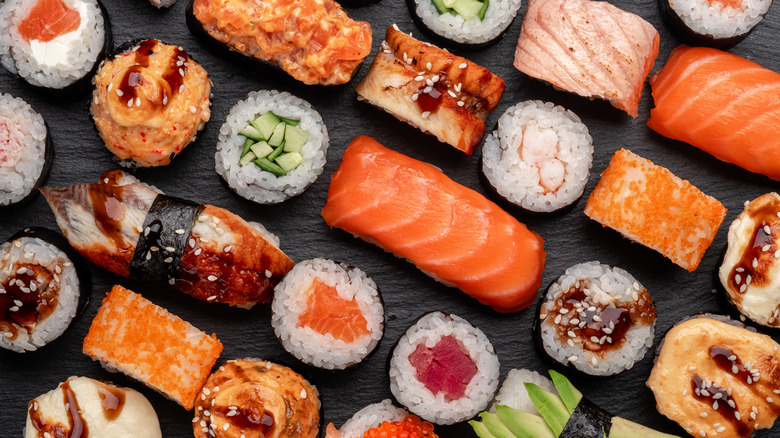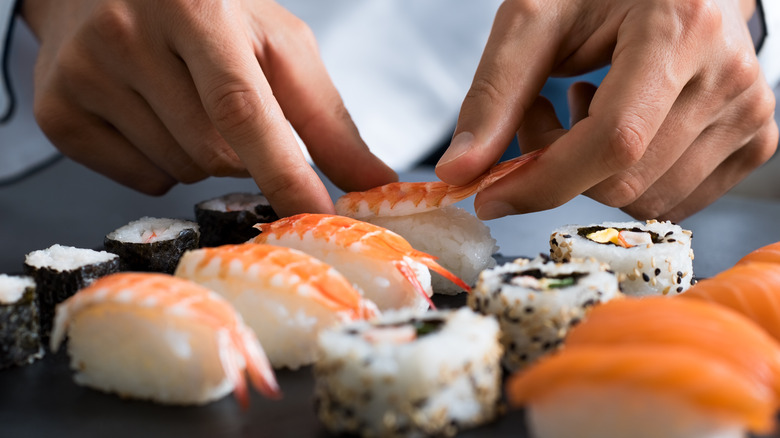You Should Avoid Trader Joe's Sushi. Here's Why.
Most grocery store visits are viewed as a necessary chore to ensure your home is stocked with the essentials. However, some supermarket chains offer an elevated experience to customers, which then creates a loyal fanbase. This is definitely the case with Trader Joe's, a chain that many shoppers swear by when it comes to price, selection, and atmosphere.
Insider highlights a few of the special characteristics that make Trader Joe's a hit with so many customers. Despite how popular how the chain is, the helpful staff ensures that checkout lines move quickly and efficiently. Customer care is also evident in Trader Joe's affordable prices, which is thanks to its private label products. Because the chain purchases items direct from suppliers, they can pass along the savings to shoppers, per Insider. Despite lower prices, customers are also privy to quality when it comes to groceries and other items found in the store. However, one item is best left on the shelf at Trader Joe's, as it doesn't meet the high standards found in the rest of the establishment.
For the freshest catches, look elsewhere
Like many supermarkets, Trader Joe's features packaged sushi for a quick and tasty dinner. However, the chain differs from other purveyors of sushi in that it doesn't make items at the store, per Reader's Digest. That means quality can be an issue, both in terms of taste and food safety. According to Web Restaurant Store, sushi must be handled properly to reduce the risk of parasites that can be consumed when fish is eaten raw. According to the FDA's "Parasite Destruction Guarantee," sushi-grade fish must be kept within a certain temperature range immediately after being caught to kill any harmful parasites that may be present.
Food can also be contaminated with certain types of bacteria that can't be killed by extreme temperatures. As explained by CNN, Trader Joe's voluntarily recalled a number of products, including many types of packaged sushi, due to fears of a listeria outbreak. A type of bacteria, listeria typically causes symptoms like nausea, stomach pain, fever, and other health issues. However, the bacteria can cause more serious effects in vulnerable people, such as those with compromised immune systems. Fortunately, no one actually became ill as a result of the contamination, as the recall was enacted as a safety measure. This incident does show how important it is to be choosey about your sushi.
How to find the best sushi
Even if you're not a bona fide sushi connoisseur, there are some things you can look for to determine quality. According to Ichi Sushi, the look and texture of the fish are major indicators. When fresh, sushi-grade fish will appear uniform in color, while also being somewhat translucent. In terms of texture, fresh catches will be springy and firm as opposed to soft and mushy. The quality of the sushi accompaniments is another important factor to consider. Rice should never appear crumbly or dry, while seaweed wraps should be crisp and not slimy or damp.
In some cases, you can even determine the quality of sushi simply by how the establishment smells. Fresh fish does not have an overpowering, "fishy" aroma. As explained by the Los Angeles Times, fresh fish has a subtly sweet, slightly briny aroma as opposed to smelling acrid or stale. If a sushi counter does smell a lot like fish, that means the catches are not fresh and quality is suspect. As a result, you should seek your sushi fix elsewhere to ensure the best culinary experience.


